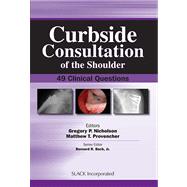
Note: Supplemental materials are not guaranteed with Rental or Used book purchases.
Purchase Benefits
What is included with this book?
| Dedication | |
| Acknowledgments | |
| About the Editors | |
| Contributing Authors | |
| Preface | |
| Physical Examination Questions | |
| What Are the Physical Examination Findings That Lead You to a Diagnosis of Glenohumeral Internal Rotation Deficit in the Throwing Athlete and What Nonoperative Treatment Options Have Led to Improvement of the Condition? | |
| What Physical Examination Tests or Findings and Radiographs Do You Use to Diagnose Subacromial Impingement, and When Do You Utilize Subacromial Injections? | |
| What Are the Physical Examination Findings (Signs and Symptoms, Pertinent Positives and Negatives) That Direct You Toward a Diagnosis of Superior Labrum Anterior to Posterior Lesion? | |
| Imaging Questions | |
| A 19-Year-Old Male Has Suffered Four Recurrent Dislocations During Sporting Activity | |
| He Has Been Able to Self-Reduce the Last Two Episodes | |
| What Is the Advanced Imaging Study of Choice? | |
| What Are the Radiographic Views Necessary to Evaluate Osteoarthritis of the Shoulder? | |
| Are These Adequate Prior to Total Shoulder Arthroplasty, or Is an Advanced Imaging Study (Computed Tomography Scan, Magnetic Resonance Imaging) Indicated? | |
| What Is the Imaging Modality To Best Diagnose a Superior Labrum Anterior to Posterior Tear and What Does It Look Like? | |
| Sports Questions | |
| How Do You Manage the Long Head of Biceps Tendon in a 28-Year-Old Weekend Athlete With a Type IV Superior Labrum Anterior to Posterior Lesion That Involves Tearing Into the Biceps and Affects at Least 25% of the Tendon Thickness? | |
| A Volleyball Hitter Has Weakness of External Rotation and Visible Atrophy of the Infraspinatus | |
| What Are the Potential Causes, What Are the Indications for Suprascapular Nerve Decompression, and What Is the Operative Approach? | |
| After a "Stinger" During a Football Game, There Is Weakness of the Deltoid, Rotator Cuff, and Biceps and Triceps | |
| Why Did This Happen and When Would You Allow Him to Return to Play Again? | |
| When Is the Patient Allowed to Return to Contact Sports After an Arthroscopic Instability Repair for Recurrent Anterior Instability? | |
| What Is the Treatment for a Patient | |
| Who Presents With a "Squeaking" Shoulder 4 Months After an Arthroscopic Labral Repair Performed With a Bioabsorbable Tack? | |
| Pediatric Questions | |
| A 14-Year-Old Pitcher Presents With Shoulder and Arm Pain | |
| It Is Midseason | |
| There Is No Instability, and the Pain Is Primarily Over the Lateral Deltoid | |
| Radiographs Reveal Widening of the Lateral Aspect of the Proximal Humeral Physis | |
| What Is the Diagnosis and Treatment Strategy? | |
| How Do You Treat a 14-Year-Old Female | |
| Who Can Voluntarily Sublux the Shoulder Posteriorly and Anteriorly, and Has a Sulcus Sign? | |
| Trauma Questions | |
| A 16-Year-Old Hockey Player Has a Collision With His Arm Forcibly Extended | |
| A Magnetic Resonance Imaging Scan Reveals a Lesser Tuberosity Fracture With 2 to 3 mm of Elevation and 2 mm of Medial Displacement | |
| Is This Due to the Apophysis of the Lesser Tuberosity? | |
| And How Do You Diagnose and Manage Traumatic Fractures of the Lesser Tuberosity of the Humerus? | |
| What Are the Indications for Open Reduction And Internal Fixation of an Isolated Greater Tuberosity Fracture, and What Approach and Operative Technique Is Appropriate? | |
| Table of Contents provided by Publisher. All Rights Reserved. |
The New copy of this book will include any supplemental materials advertised. Please check the title of the book to determine if it should include any access cards, study guides, lab manuals, CDs, etc.
The Used, Rental and eBook copies of this book are not guaranteed to include any supplemental materials. Typically, only the book itself is included. This is true even if the title states it includes any access cards, study guides, lab manuals, CDs, etc.